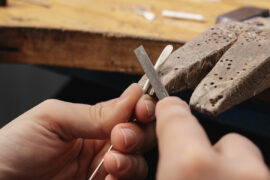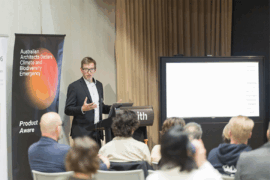In town to inaugurate Business of Design Week’s ‘Designed by Hong Kong’ lecture series, Japanese designer Naoto Fukasawa tells us about his design philosophy, dream project and what minimalism really means. Christie Lee files this report.

July 20th, 2014
If there is single, definitive Naoto Fukasawa style, it is perhaps one of simplicity and humility. The Japanese designer has a penchant for crafting objects that blend so seamlessly with the surrounding environment that you hardly notice them until much later. And none epitomises this ethos better than the MUJI CD player. A whimsical ode to whirling ventilation fans, it became a part of the Museum of Modern Art’s permanent collection in 2004.
Born in the Yamanashi Prefecture in 1956, Fukasawa studied at the Tama Art University before being tapped as head of IDEO’s Tokyo Office in the 1980s. Since establishing his eponymous brand in 2003, he has gone on to design such iconic products as the Hiroshima chair and the Infobar A02. We find out more.

(Left) Hiroshima chair for Maruni. (Right) MUJI CD Player
What is your design philosophy?
A lot of people think that a good design should evoke emotions. From my perspective, a good design should have the ability to blend in with your everyday life. You aren’t conscious of its existence. When it comes to finding the best design, your senses are the best judge.
Which comes first – form or function?
Definitely function.

Demetra task lamp for Artemide
A lot of people label your work as ‘minimalist’. What is a minimalist design?
A minimalist design isn’t the same as a simple design. By doing away with all the frills, a minimalist design focuses on the way a product, be it a chair or a lamp, fits our lifestyle.
Like the Hiroshima chair you designed for Maruni Wood Industry?
Yes, we designed it so that it’d accommodate a range of body sizes and lower-limb postures.
What is your proudest achievement so far?
The Hiroshima chair and the MUJI CD player.
Do people from different countries have different levels of appreciation for the same design?
Yes, but the divide is between individuals rather than nations. The production process differs from country to country though. Japanese designers are very slow when it comes to making decisions!
What do you want to design next?
A house. I’ve done interiors before, but I’d like to do more. Basically I want to have a box where I can put all my favourite designs.
Naoto Fukasawa
naotofukasawa.com
INDESIGN is on instagram
Follow @indesignlive
A searchable and comprehensive guide for specifying leading products and their suppliers
Keep up to date with the latest and greatest from our industry BFF's!

London-based design duo Raw Edges have joined forces with Established & Sons and Tongue & Groove to introduce Wall to Wall – a hand-stained, “living collection” that transforms parquet flooring into a canvas of colour, pattern, and possibility.

As a supporter of the INDE.Awards and partner of The Design Studio category, Herman Miller understands the importance of fostering and supporting designers in their quest for design perfection.

They say Australians are an intrepid bunch. Never was it more apparent than at Business of Design Week in Hong Kong, last week, which saw hundreds of Melbourne and Victoria-based designers head over to this burgeoning metropolis for a week of seminars and city experiences.
The internet never sleeps! Here's the stuff you might have missed

Join CPD Live from 14-16 October for three days of live, interactive education – 100% online, 100% free, and packed with insights to keep your knowledge current and earn CPD points.

Having recently attended the Symposium as the Murcutt Pin-holder, Sydney-based architect Jamileh Jahangiri reflects on the importance of the gathering.

In a landscape clouded by data and greenwash, Product Aware offers architects and designers a common language for sustainability. Embraced by suppliers – including Milliken – it is setting a new benchmark for trust and bringing clarity and accountability to material specification.